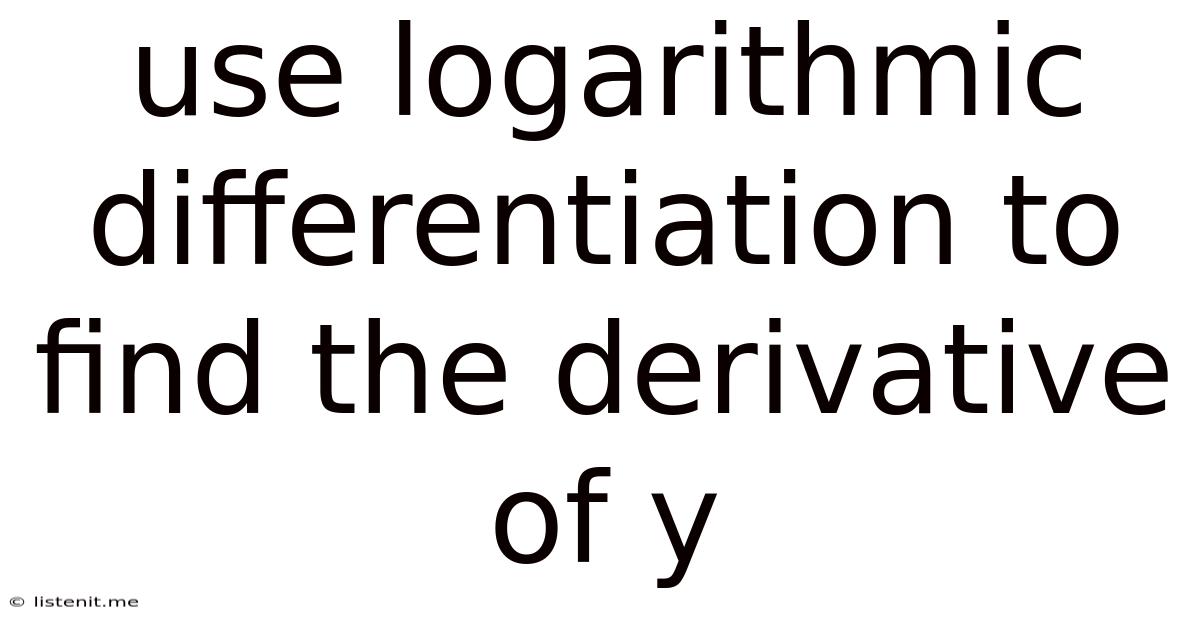Use Logarithmic Differentiation To Find The Derivative Of Y
listenit
May 09, 2025 · 4 min read

Table of Contents
Use Logarithmic Differentiation to Find the Derivative of y
Logarithmic differentiation is a powerful technique used to find the derivatives of complicated functions, particularly those involving products, quotients, and powers of functions. It leverages the properties of logarithms to simplify the differentiation process, making it significantly easier to handle complex expressions. This article will comprehensively explore logarithmic differentiation, providing a step-by-step guide, examples, and insights into its applications.
Understanding the Core Principle
The fundamental idea behind logarithmic differentiation hinges on the properties of logarithms, specifically:
- Log of a Product: log(ab) = log(a) + log(b)
- Log of a Quotient: log(a/b) = log(a) - log(b)
- Log of a Power: log(a<sup>b</sup>) = b*log(a)
By applying these properties, we can transform complex functions into simpler forms that are more readily differentiable. The process typically involves these key steps:
- Take the natural logarithm (ln) of both sides of the equation: This allows us to utilize the logarithmic properties.
- Simplify the expression using logarithmic properties: This transforms the original complex function into a more manageable form.
- Differentiate both sides of the equation implicitly with respect to x: Remember to apply the chain rule where necessary.
- Solve for dy/dx: Isolate the derivative to obtain the final result.
Step-by-Step Guide with Examples
Let's illustrate the process with several examples, progressing in complexity.
Example 1: A Simple Product
Find the derivative of y = x²(x+1)<sup>3</sup>
-
Take the natural logarithm: ln(y) = ln[x²(x+1)<sup>3</sup>]
-
Simplify using logarithmic properties: ln(y) = 2ln(x) + 3ln(x+1)
-
Differentiate implicitly: (1/y) * (dy/dx) = 2/x + 3/(x+1)
-
Solve for dy/dx: dy/dx = y * [2/x + 3/(x+1)] = x²(x+1)<sup>3</sup> * [2/x + 3/(x+1)]
This simplifies further, but the key is that the logarithmic differentiation significantly simplified the process of finding the derivative compared to applying the product rule and chain rule directly.
Example 2: A Complex Quotient
Find the derivative of y = (x³ + 2x) / (x² - 1)<sup>½</sup>
-
Take the natural logarithm: ln(y) = ln[(x³ + 2x) / (x² - 1)<sup>½</sup>]
-
Simplify using logarithmic properties: ln(y) = ln(x³ + 2x) - ½ln(x² - 1)
-
Differentiate implicitly: (1/y) * (dy/dx) = (3x² + 2) / (x³ + 2x) - [x/(x² -1)]
-
Solve for dy/dx: dy/dx = y * [(3x² + 2) / (x³ + 2x) - x/(x² - 1)] = [(x³ + 2x) / (x² - 1)<sup>½</sup>] * [(3x² + 2) / (x³ + 2x) - x/(x² - 1)]
Again, notice how logarithmic differentiation broke down a complex quotient into manageable terms for differentiation.
Example 3: A Function Raised to a Power of a Function
Find the derivative of y = (x<sup>2</sup> + 1)<sup>sin(x)</sup>
This example showcases the power of logarithmic differentiation when dealing with functions raised to functions.
-
Take the natural logarithm: ln(y) = ln[(x<sup>2</sup> + 1)<sup>sin(x)</sup>]
-
Simplify using logarithmic properties: ln(y) = sin(x) * ln(x<sup>2</sup> + 1)
-
Differentiate implicitly: (1/y) * (dy/dx) = cos(x) * ln(x<sup>2</sup> + 1) + sin(x) * [2x/(x<sup>2</sup> + 1)]
-
Solve for dy/dx: dy/dx = y * [cos(x)ln(x<sup>2</sup> + 1) + 2xsin(x)/(x<sup>2</sup> + 1)] = (x<sup>2</sup> + 1)<sup>sin(x)</sup> * [cos(x)ln(x<sup>2</sup> + 1) + 2xsin(x)/(x<sup>2</sup> + 1)]
Advanced Applications and Considerations
Logarithmic differentiation extends beyond these basic examples. It's particularly useful in:
- Derivatives of complicated exponential functions: Functions where the exponent itself is a function of x are efficiently handled using this technique.
- Implicit differentiation involving complex expressions: It simplifies the process of finding derivatives in implicit functions with products and quotients.
- Finding derivatives of parametric equations: When dealing with equations defined parametrically, logarithmic differentiation can provide a more straightforward approach.
Important Note on the Domain: Remember that the natural logarithm is only defined for positive arguments. Therefore, when applying logarithmic differentiation, ensure that the function you're working with is positive within the relevant domain. If the function can take negative values, you might need to consider absolute values or restrict your domain accordingly.
Comparison with Other Differentiation Techniques
While other techniques, such as the product rule, quotient rule, and chain rule, can also be used to find the derivatives of such functions, logarithmic differentiation often offers a more efficient and less error-prone approach, especially when dealing with intricate expressions. Directly applying the product, quotient, and chain rules repeatedly can lead to cumbersome calculations and a higher chance of making mistakes.
Conclusion
Logarithmic differentiation is an invaluable tool in the calculus arsenal. Its ability to simplify complex expressions through logarithmic properties makes it a significantly more efficient method for finding derivatives of functions involving products, quotients, and powers. Mastering this technique will greatly enhance your ability to tackle complex differentiation problems effectively and accurately. While it's essential to understand the foundational rules of differentiation, logarithmic differentiation provides a powerful shortcut for dealing with particularly challenging scenarios. Remember to always carefully consider the domain and potential restrictions when using natural logarithms. By practicing with various examples, you'll become proficient in applying this versatile and essential technique.
Latest Posts
Latest Posts
-
Which Process Can Separate Out The Solute From The Solvent
May 11, 2025
-
Find Four Consecutive Integers With The Sum Of 54
May 11, 2025
-
Least Common Multiple Of 3 4 And 8
May 11, 2025
-
What Is The Least Common Multiple Of 16
May 11, 2025
-
A Major Weakness Of The 1920s Economy Was The
May 11, 2025
Related Post
Thank you for visiting our website which covers about Use Logarithmic Differentiation To Find The Derivative Of Y . We hope the information provided has been useful to you. Feel free to contact us if you have any questions or need further assistance. See you next time and don't miss to bookmark.